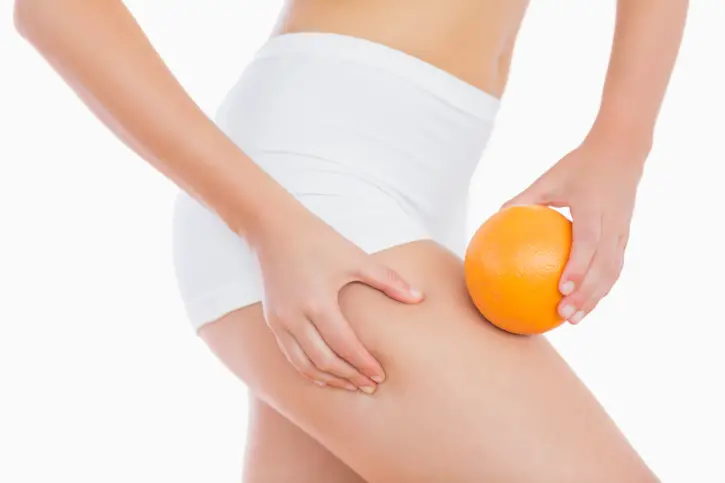If you are wondering what is cellulite because you are impacted with it or are worried that one day you may start to show signs of seeing cellulite present on your body, it’s time that you learned the in’s and out’s of what this unsightly tissue is all about.
Cellulite is a problem that many people face and one that they can’t always cure through simple diet and exercise techniques to lose weight. At times, you need to take things a little further if you want to see the absolute best cellulite reducing results.
Let’s go over what cellulite is so that you can answer this question once and for all.
What Is Cellulite?
The very first thing we need to discuss is what is cellulite. Many people aren’t entirely sure what this tissue actually is and mistakenly believe that it’s just stored body fat.
While body fat is definitely part of the cellulite forming process, it’s not the only factor at play. Cellulite is a problem that occurs not only because of excess body fat, but also because of the way the skin is formed in that particular region of the body.
Cellulite itself is going to be tissue that takes on a dimpled like appearance where you see small pockets forming on the skin. These pockets are often not all that large, but are rather localized to just one area of the body, most notably occurring in the buttocks, thighs, and sometimes in the lower abdominal region.
Cellulite is more likely to occur in these areas of the body due to the fact that this is where you naturally will store more body fat, so there will be a higher volume of fat built-up near the skin’s surface.
In addition to this, these are the areas of the body where circulation also tends to be lower, so this can also be in part what leads to a higher amount of cellulite there compared to other areas of the body.
Cellulite is going to form when fat seeps in between the skin and the attachments that connect the skin to muscle tissue, thus creating that pocket-life effect that you see when you look at an area of the body that contains cellulite. The greater the pocket number and the deeper the holes form, the more prevalent cellulite will be.
When looking at what is cellulite, you can classify it into three different levels.
The first level, grade 1, is cellulite that shows no clinical symptoms at all, but when viewed at a microscopic level, you will notice changes taking place under the surface of the skin where cellulite is formed. This is the least severe of all the forms of cellulite and is often not seen by the naked eye.
The second level, grade 2 cellulite, is more visible by the naked eye and occurs when there is a reduced level of elasticity in the skin over top of the cellulite.
This level is going to be where the individual suffering starts complaining about the cellulite as they can easily see it in the mirror while undressed. Despite the fact that it is visible, it’s still not all that severe and can likely be reduced with proper cellulite treatment methods.
Finally, third level cellulite, grade 3, is going to be where you can actually feel the roughness of the skin when you touch it and where there is going to be a much more pronounced change to the appearance of your skin.
Those who are suffering from this level of cellulite will need more aggressive treatment methods to rid themselves of it and in some cases, it won’t be able to be removed.
Grade 3 cellulite often does occur in those who are much more overweight as it will take a higher level of fat to build up to this degree.
Who Gets Cellulite?
So now that you know more clearly what is cellulite, it’s time to look at who gets cellulite.
Some people may come to think that this is a ‘fat person’s’ condition.
While it’s true that the more overweight you are, the more likely you are to experience signs and symptoms of cellulite, you are by no means immune if you are at a normal body weight.
Females do tend to experience cellulite more often than males and this is due to the fact that women have a higher level of required body fat for the child birthing process.
While men can easily maintain body fat levels of around 10% without too much trouble, for a woman to get this low she would have to sacrifice her health. Because of this fact, she is going to be more prone to experiencing problems with cellulite.
In addition to this, females are also more likely to see cellulite than males on their body due to the hormonal composition of their body.
Men have high levels of testosterone in their body, which is what helps them stay muscular and lean. Females on the other hand have much higher levels of estrogen and progesterone, two hormones that can actually encourage additional fat accumulation.
This further increases the chances that they are going to see cellulite.

Finally, the last risk factor that puts you at a higher chance of seeing cellulite is if you are inactive. Inactive individuals typically lack the lean muscle mass that would push the fat up against their skin, reducing the chances that the dimpled pockets are formed.
Instead, inactive people see loose skin and less definition overall, increasing the appearance of cellulite. This is why exercise is such an important treatment for getting rid of cellulite permanently.
So there you have the top things that you need to know about what is cellulite. Cellulite, while frustrating, can be treated if you go about things correctly and use the proper protocol including a sound diet plan and proper workout program.

